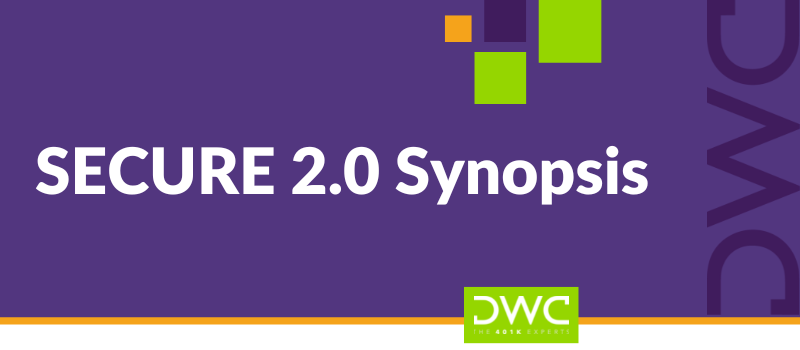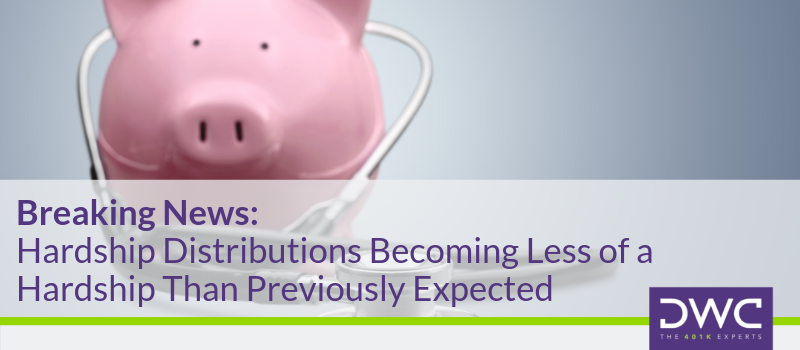Nearly a year after Congress passed changes to the hardship distribution rules in the Bipartisan Budget Act and the Tax Cuts and Jobs Act, the IRS has published proposed regulations to fill in some of the details on how to implement the new rules.
The proposed regulations pave the way for three general changes:
- Remove most of the restrictions on the types of contributions that are available,
- Expand the reasons a participant can take a hardship distribution, and
- Eliminate the requirements to first take a participant loan and to suspend deferrals for six months following the distribution.
As a whole, these changes are meant to make it easier for participants to access their accounts when they have a true hardship, while also avoiding the pesky contribution suspension that delayed them from replenishing their accounts and continuing to save for retirement.
Setting a Single Standard
The proposed rules simplify the overall standard used to determine whether a hardship distribution is allowed by eliminating the “facts and circumstances” review and focusing on three requirements:
- The amount of the distribution cannot exceed the amount of the financial need (including any amount necessary to pay any taxes or penalties reasonably expected to result from the distribution.
- The participant must have taken all available distributions from the plan or other plans sponsored by the employer. However, the participant is no longer required to first take a loan.
- The employee does not have other sufficient cash or liquid assets to satisfy the need. Plan sponsors can rely on an employee’s representation unless there is actual knowledge to the contrary.
That’s it. A simple, single standard. Of course, it still has to be for one of the established criteria (see more below), but the review standard is now simpler.
Suspending the Suspension
Current rules require a participant to suspend making contributions for six months after taking a hardship distribution.
The fantastic news is that the new rules remove this requirement so that participants can continue to grow their retirement savings; which is ultimately the point. The timing for this change, though, is a little more convoluted.
Suspending contributions will be completely prohibited for plan years beginning in 2020. So, what do I do about 2019? We’re glad you asked! The short answer is that it’s up to you, but in general, there are several options:
- You can continue to apply the 6-month suspension for all hardships taken through the end of the 2019 plan year.
- You can, but are not required to, eliminate the suspension for any hardships taken during the 2019 plan year.
- For participants who take/have taken a hardship in the latter half of 2018, you can either let the full six-month suspension play out, or you can cut the suspension short as of the first day of 2019.
Even though you have options, there are two caveats. First is that all participants must be treated consistently. Second, however you choose to implement the new rules must eventually be documented in an amendment, so it is critical to keep track. Anecdotally, we anticipate that most of our clients will elect to end all current suspensions at the beginning of 2019 and eliminate them going forward.
Expanding the Reasons
The Tax Cuts and Jobs Act changed the rules so that losses related to casualty damage to a primary residence are only tax-deductible to the extent the damage occurred in a federally declared disaster area. Since deductible casualty losses to a primary residence were one of the hardship criteria, this change had the unintended consequence of further limiting access to a hardship distribution. Not only do the proposed regulations reverse that, they go one step further to expand the criteria as follows:
- Deductible casualty losses to a primary residence (regardless of whether or not it is in a federally declared disaster area),
- Qualifying medical, education, and funeral expenses incurred by not only the participant, spouse or a dependent but also by the participant’s designated primary plan beneficiary,
- Expenses that result from a federally declared disaster, e.g. hurricanes, floods, wildfires, etc. (so that participants can access their accounts without waiting for specific authorization for each FEMA-declared disaster).
The other existing criteria continue to remain in place, and these new criteria may be applied to distributions made on or after a date as early as January 1, 2018. You read that right – 2018. So, for example, an employer that accidentally approved a hardship distribution during 2018 for a casualty loss that was not in a federally-declared disaster area may amend its plan document so that the distribution becomes retroactively acceptable.
Making All Money Types Available
In the past, some types of contributions were available for hardship, while others were not. For some contribution types, participants could withdraw only the contributions but not any investment gains. The proposed rules change all of that to put all money sources on a level playing field. As of January 1, 2019, a plan can make all plan accounts (including earnings) available for hardship distribution. Of course, it is still allowable to limit such distributions to certain sources, but the flexibility going forward should definitely ease administration.
That’s a great story, but as is always the case in the world of qualified retirement plans, there is an exception. In this case, the exception is the 403(b) plan.
Treating 403(b) Plans Differently
For the most part, the hardship rules for 403(b) plans follow those for 401(k) plans. So, the proposed changes will generally also apply to 403(b) plans. That said, the new rules do not mention the earnings related to 403(b) deferrals, resulting in those earnings continuing to be ineligible for distribution due to hardship.
Additionally, Qualified Nonelective Contributions (QNECs) and Qualified Matching Contributions (QMACs) are only eligible for hardship distribution from a 403(b) plan to the extent they are not held in a custodial account; those that are held in a custodial account are still ineligible under the new hardship rules.
Amending Your Plan
These proposed rules greatly expand the availability of hardship distributions and simplify their administration. As described above, the changes are generally effective beginning with the 2019 plan year; however, some provisions (elimination of the suspension period) can be delayed until 2020 and others (additional criteria) can be applied retroactively to 2018.
Ultimately, the plan document is the driving force behind what you can do and when you can do it. The new rules provide guidance on what is allowed, but your plan document will need to be amended to specify exactly how you will implement the changes. The exact timing of those amendments is yet to be determined, but rest assured that the DWC team is on it and will follow keep you posted with future developments.
For more information on hardship distributions, visit our Knowledge Center here and here.











